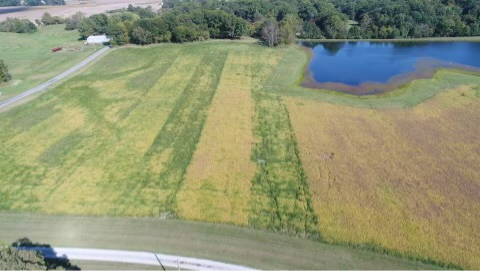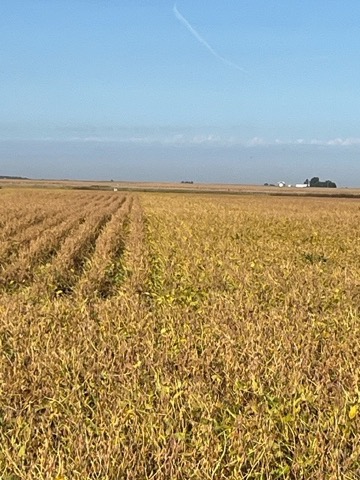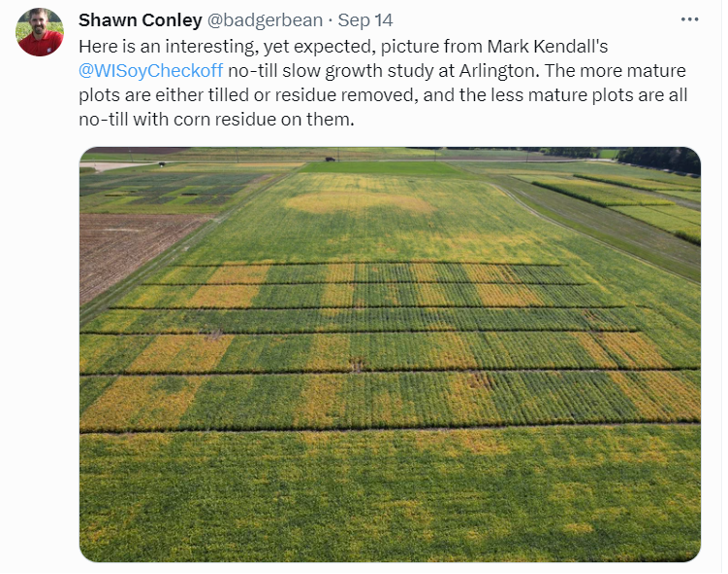Researchers around the state are continuing to study and learn about the impact of cover crops on soybean growth and development and grain yield. Follow along to hear from three experts on observations from this season and questions they are asking themselves in preparation for the 2024 growing season.
John Pike, an independent agronomist from Marion, IL, shares an update on a cover crop strip-trial from his farm that he originally discussed in this video.
“Timing of the herbicide application to kill cover crops made a difference with the dry conditions at planting. In the picture below, the greener strips to the left are where soybeans were planted into a mature cover crop. Cereal rye and annual ryegrass were the dominant cover crop species. There was also some crimson clover and dwarf essex rapeseed in the mix at planting, but it was very dry last fall, and the clover and rapeseed did not germinate in force until the spring, so the impact of those species was not a factor,” according to Pike.
“There was no cover crop located between the “greener strips” and the soybeans came up quicker and looked better all summer. So, a quick conclusion on that observation alone might suggest that the cover crop held the beans back because of “drier” conditions they created. So why would we want to do that?”
But wait! There’s more.
Pike adds, “The bigger patch on the right that is maturing faster had the same cover crop as the greener strips. The only difference between that section of the field and the greener cover crop strips was spraying to kill the cover crop in early April rather than late May. That part of the field has looked best all year. So, it is good to compare more than the extremes because the best way might be somewhere in between.”

The large patch on the right was cover crop and terminated in early April. Moving left, the green strips were planted green into cereal rye in late May. The browner strip in the middle of the very green strips is no cover crop.
Earlier this season, we received a research update from Dr. Giovani Preza Fontes, Assistant Professor and Field Crops Extension Agronomist at University of Illinois, about his Illinois Soybean Association (ISA) funded research project, “Adaptive Management for Maximizing Soybean Production Following Cereal Rye Termination.” This project is in collaboration with Dr. Shalamar Armstrong and Dr. Shaun Casteel from Purdue University, and 2023 is the first growing season for the study. Two sites in Illinois and three in Indiana are in place this year with the Indiana sites supported by the Indiana Soybean Alliance. Preza Fontes and his collaborators hope to better understand the situations that could impede soybean development and yield following cereal rye cover crop and develop adaptive management strategies to mitigate potential nitrogen and sulfur deficiencies. This study will be replicated in 2024 and preliminary results from 2023 will be shared in the winter.
At the Urbana site, Preza Fontes observed that the soybean growth (specifically height and richness of green color) in the cereal rye plot was slower at the beginning of the season compared to soybeans without cereal rye. The soybeans following cereal rye caught up to those without cereal rye in terms of growth stage and were all at R3 on August 1. Hear more from Preza Fontes in his video update.
Dan Schaefer, Director of Nutrient Stewardship at the Illinois Fertilizer and Chemical Association, has questions coming to mind as this growing season winds down.
“Do no-till soybeans potentially have a longer grain fill period from slower growth? Below is a picture of a replicated trial with 30” row strip-till and 15” row no-till all with a cover crop. The same soybean variety is also in a conventional tillage field, and they are 2 days from being harvested as of September 26, 2023.”

A replicated soybean trial with 30” row strip-till on the left and 15” row no-till on the right. Both were planted following a cover crop.
In response to Schaefer’s question, Preza Fontes said, “This is something that we could try and document with tillage by fertilizer management of soybeans next year. Identifying the drivers of the “slow growth” is critical for managing soybeans in conservation tillage systems.” Preza Fontes also noted that Dr. Shawn Conley, Professor and Soybean and Wheat Extension Specialist at University of Wisconsin, made a similar observation on September 14th via X:

What conclusions can we draw from these observations? We can be reaffirmed that management of cover crops matter just like any other product or seed placed or an implement pass on our fields. Adding cover crops into a system needs to be thoroughly planned out and strategies in place to manage the cover to get the greatest benefit from their addition to the field. Regarding slow growth of soybeans following a cover crop, we should note that this may not always be a bad thing, but there are plenty of questions researchers will help address to fine-tune these observations. Stay tuned for future research updates, and as always, please reach out the ISA Agronomy team with ideas for future research trials. Thanks to our experts for sharing their thoughts and takeaways so far from the 2023 growing season!
If you have questions or a great idea for an on-farm trial, reach out to Abigail Peterson, ISA Director of Agronomy and CCA, at Abigail.Peterson@ilsoy.org or visit Superior Soybean Systems – ILSoyAdvisor.




 and then
and then